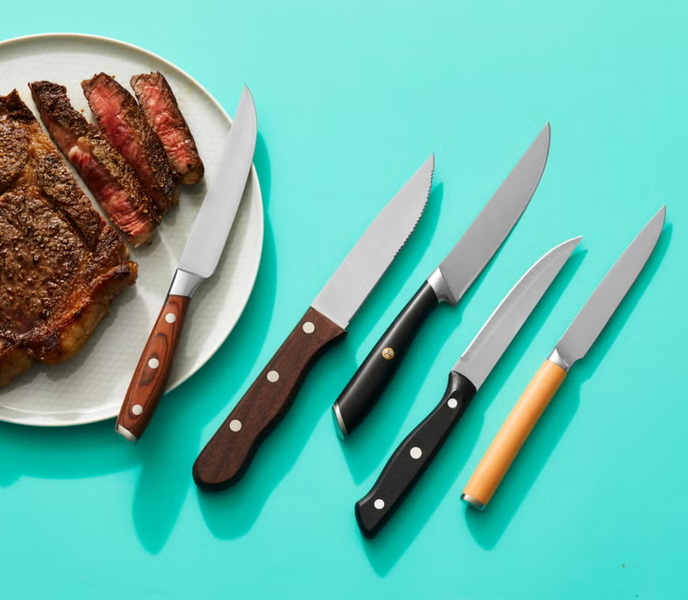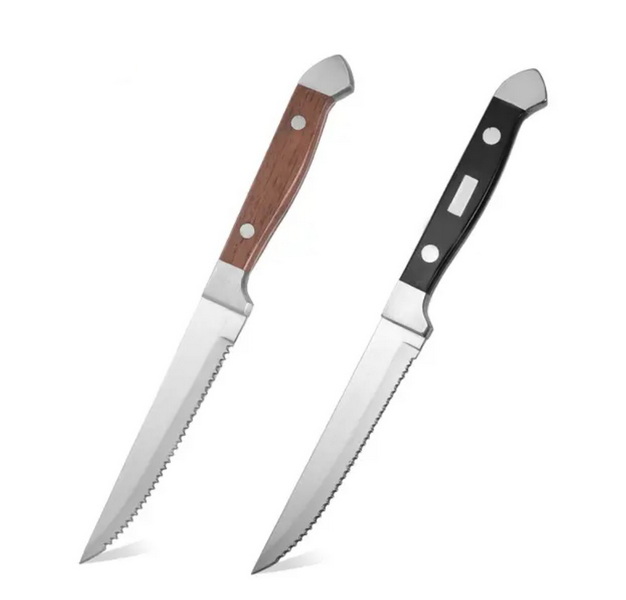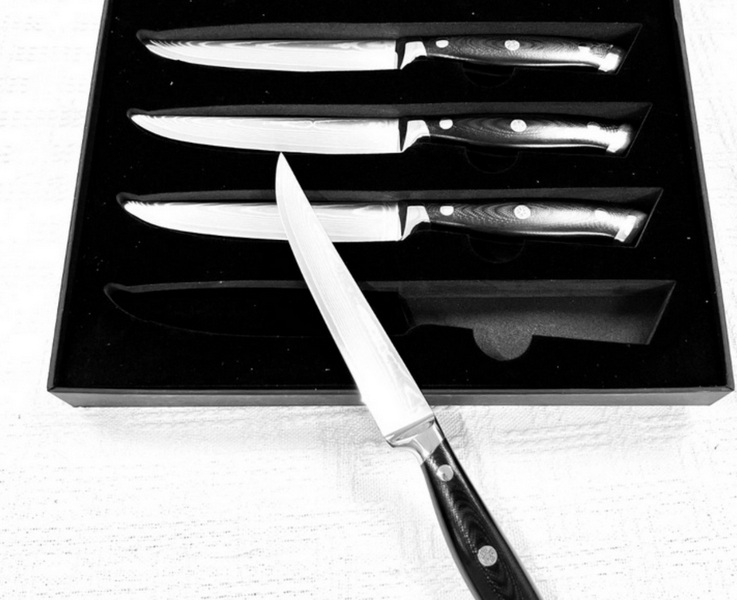- All
- Product Name
- Product Keyword
- Product Model
- Product Summary
- Product Description
- Multi Field Search
Views: 222 Author: Ann Publish Time: 2025-10-28 Origin: Site











Content Menu
● Market foundations and value propositions
● Overview of OEM opportunities in China
● Material science and manufacturing options
>> Blade materials and heat treatment
>> Blade geometry and grinding
>> Handle materials and ergonomics
>> Coatings, finishes, and corrosion resistance
● How to evaluate a steak knife supplier in China
● Design and development for OEM steak knives
● FAQ
>> What is the typical steel grade used for steak knives in OEM production?
>> Which handle materials are most durable for restaurant environments?
>> What are standard MOQs for private-label steak knives?
>> How long does private-label production usually take from design to shipment?
>> What certifications should an OEM steak knife supplier possess?
China has long stood as a global powerhouse in kitchen cutlery production, and steak knives constitute a core segment within this ecosystem. For foreign brands, wholesalers, and OEM producers seeking private-label solutions, China offers an expansive supplier base, advanced machining capabilities, and flexible customization options. This article surveys leading steak knife manufacturers in China, highlighting their core strengths, material offerings, manufacturing processes, and OEM capabilities, with a focus on enabling informed sourcing decisions.

The Chinese steak knife sector blends traditional craftsmanship with modern manufacturing technology. Forging expertise, precision grinding, and meticulous heat treatment converge with CNC machining, laser cutting, and surface finishing to produce durable, sharp, and aesthetically pleasing blades. For OEM partnerships, key value propositions include private-label packaging, logo engraving, handle material customization, blade steel options across a broad spectrum, and scalable production to meet varying MOQs and lead times. In addition, many factories offer design support, rapid prototyping, and in-house quality assurance programs that align with international standards. This combination makes Chinese steak knife manufacturers strong candidates for brand owners seeking consistent quality at competitive pricing, without compromising on performance or food-safety requirements. The emphasis on Steak Knife as a core product ensures readers can align sourcing strategies with market expectations across hospitality, retail, and professional kitchen segments.
OEM opportunities in China often encompass private-label branding, packaging customization, CAD-to-prototype collaboration, and full supply-chain support from steel sourcing to final packaging. For steak knives, typical OEM features include:
- Blade materials ranging from high-carbon stainless steels to advanced stainless alloys and Damascus-layered designs, balancing hardness, corrosion resistance, and edge retention.
- Blade geometries optimized for slicing and portion control, with serrated and non-serrated options.
- Full-tang construction, reinforced bolsters, and ergonomic handles in materials such as POM, G10, pakkawood, rosewood, or stainless steel.
- Private-label packaging, branding logos, colorways, and photoshoots tailored to retailer requirements.
- MOQs and lead times adaptable to samples, trial orders, and full-scale launches.
By understanding these dimensions, brand partners can calibrate expectations around product performance, regulatory compliance, and time-to-market.
- Stainless steel families: 420J2, 440C, AUS-8/10, and other high-carbon stainless variants, chosen for balance between hardness and corrosion resistance.
- High-end steels: VG-10, SG2, and related powder metallurgy options, offering greater hardness and edge retention for premium lines.
- Damascus and layered steels: Multi-layer constructions for aesthetic appeal and enhanced grit stability, with careful control of wear resistance.
- Heat treatment targets: a typical steak knife may seek hardness in the range of HRC 56–60 for balanced performance, while premium lines may push toward HRC 60–62, with tempering to reduce brittleness.
- Grind profiles: flat grind, hollow grind, and chisel options, selected based on desired cutting feel and longevity.
- Edge geometry: micro-bevels, double-bevels, and sharpened edge angles tailored for smooth slicing through flesh-and-fat boundaries in steaks.
- Serration options: serrated blades for bread-and-steak combos or straight-edge blades for precise meat slicing.
- Wood-based handles: pakkawood, rosewood, and other aesthetics-focused finishes offering warmth and grip.
- Composite and synthetic: POM, G10, FRN for durability, hygiene, and cost efficiency.
- Stainless combinations: stainless-steel bolsters or full-stainless builds for heavy-use environments (restaurants, catering).
- Ergonomics: careful balance, palm-fit contours, and finger grooves to reduce fatigue during long periods of slicing.
- Finishes: mirror polish for aesthetics, satin or brushed finishes for hide-and-wear resistance.
- Coatings: PVD or other protective coatings to enhance corrosion resistance and reduce staining on certain blade alloys.
- Food-safety considerations: compliant processes and solvents, with traceability for materials and coatings.

- Incoming quality control (IQC) for raw materials, with supplier verifications and certificate checks.
- In-process inspection at key stages: forging, grinding, heat treatment, edge honing, and handle assembly.
- First-article inspection (FAI) to validate design intent before full-scale production.
- Final QA tests: hardness verification, balance checks, corrosion resistance, edge sharpness, and visual finish.
- Packaging and labeling checks to ensure branding fidelity and tamper-evidence where required.
International certifications (e.g., ISO, BSCI) are often pursued to support export readiness and quality assurance storytelling.
- Material integrity and process transparency: request full material certificates (certificate of conformity, mill/test reports) and data on heat treatment cycles.
- Quality assurance and traceability: inquire about QA processes, SPC data, and the ability to provide a bill of materials (BOM) with supplier lot tracing.
- Prototyping and design support: confirm access to CAD files, prototypes, and user testing programs, as well as iterations based on feedback.
- Intellectual property protection: ensure NDAs, IP protection agreements, and clear tooling ownership terms.
- Logistics and after-sales support: assess packaging options, shipping terms (EXW, FOB, CIF), and post-sale support including replacements for defects.
- Factory visits and virtual tours: arrange on-site or virtual audits to observe QC labs, grinding stations, and packaging lines.
- Design brief and concept development: translate brand values, target audience, and price positioning into blade geometry, handle shapes, and finish.
- Prototyping pipeline: 3D models, physical samples, and user testing; track revisions and approvals with clear milestone gates.
- Production ramp and QA: define process controls, sample testing frequencies, and tolerances for blade thickness, balance, and edge geometry.
- Packaging and branding: finalize packaging artwork, colorways, and tamper-evident features; align with retailer requirements and regional certifications.
- Compliance and labeling: ensure product labeling meets destination market regulations, including language requirements and safety notices.
China's steak knife manufacturing ecosystem offers a compelling combination of material diversity, design flexibility, scalable OEM capabilities, and robust quality control. For foreign brands, wholesalers, and producers aiming to build or expand private-label steak knife programs, partnering with Chinese manufacturers can deliver reliable supply, customization breadth, and efficient time-to-market. The most effective collaborations hinge on clear design briefs, transparent QA data, well-defined MOQs, and a shared commitment to brand integrity and food-safety compliance. Readers are encouraged to begin conversations with shortlisted suppliers, request prototypes and BOMs, and explore private-label opportunities that showcase unique steak knife designs and packaging that resonate with target markets.

Answer: Common grades include high-carbon stainless variants such as AUS-10 or VG-10, with premium lines exploring Damascus-based designs to balance hardness, edge retention, and corrosion resistance.
Answer: G10 and pakkawood offer strong grip and durability; stainless-steel or composite handles provide excellent sanitation and longevity in high-volume kitchens.
Answer: MOQs vary by factory, typically ranging from a few thousand pieces for pilot runs to tens of thousands for full-scale launches; many suppliers accommodate smaller pilots to attract new brands.
Answer: Timelines depend on complexity, but design-to-prototype phases may span 4–8 weeks, plus 6–12 weeks for mass production and final packaging, with faster options possible for simpler configurations.
Answer: ISO quality management, ITAQ/ITL for process controls, and supplier-specific certifications like BSCI or organic/sustainable materials credentials if relevant to packaging or coatings.
The Ultimate Professional Knives for Halal Butchery in Middle Eastern Kitchens
Chef Knife Size Guide: Choosing Between 6″, 8″, 10″, And 12″
Custom Knife Handles: How To Design A Chef Knife That Fits Your Hand Perfectly
Chef Knife Surface Treatments Guide: From Polished Migaki To Damascus Patterns
Inside Our Professional Knife Sample Room: Quality You Can See
Universal Knife Block Buying Guide: Modern Acrylic & ABS Knife Holders for Professional Kitchens
Universal Knife Block: The Complete Guide To Modern, Hygienic Knife Storage
The Complete Guide To Red Handle Knife Sets: Style Meets Functionality in The Kitchen
Professional Knives for Halal Butchery And Middle Eastern Cuisine